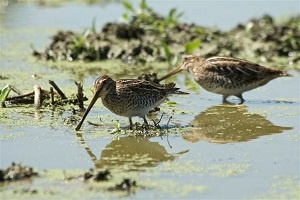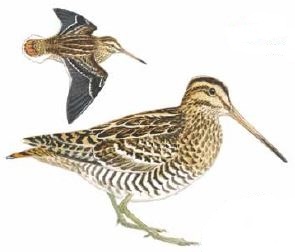Jack Snipe 🠉
Lymnocryptes minimus
_red_opt.jpg)
Small snipe, markedly smaller in size than the Common Snipe with a short bill. When it is flushed (usually when it is almost trodden on) it takes off silently, and lands again not far away. In flight, the tail is pointed. At rest, the crown is dark (it shows a pale central stripe in the other two species), the chest is streaked. When feeding, the front of the body is bounced rapidly up and down.
L. 18-20 cm. W. 33-36 cm.
Similar species: Common Snipe, Great Snipe.
©Aurélien Audevard
Common Snipe🠉
Gallinago gallinago

Slenderer and more delicately-built snipe with narrower wings than the Great Snipe, and with a very long straight bill. Rises in zigzag flight when flushed, climbing high and flying a long way. In flight, the underwing is more contrasted, with broad pale bands, and the tail is mainly rusty with white edges. At rest, the belly is white with no bars.
Call frequently heard in flight: harsh “ketch”.
L. 23-28 cm ; W. 39-45 cm.
Similar species: Great Snipe, Jack Snipe.
©Maurice Benmergui - ONCFS
Great Snipe🠉
Gallinago media

Compared with the Common Snipe, it is slightly larger in size, and a little heavier with a slightly shorter bill. When flushed the wingbeats are audible, it flies less far than the Common Snipe, and its flight is more direct and lower. The coarsely dark-barred underwing creates a dark appearance in flight, while above, the coverts are broadly edged with white to form a noticeable white wingbar along the edges of the dark greater coverts and the primary coverts. On the other hand, the pale trailing edge of the wing is indistinct and narrow (clear and broad in the Common Snipe). The tail is very white. At rest, the underparts are almost completely barred.
The flight call (rarely heard) is muffled.
L. 26-30 cm ; W. 43-50 cm.
Similar species: Eurasian Woodcock, Common Snipe.
©Serge Nicolle
Eurasian Woodcock🠉
Scolopax rusticola

Crepuscular wader mainly found in dense woodland, interspersed with fields and clearings.
The Eurasian Woodcock is the same size as a pigeon. It has a plump, pot-bellied silhouette in flight with broad rounded wings and a long straight bill. When flushed, it takes off with a loud whirring of the wings and weaves its way among the trees.
L. 33-38 cm ; W. 55-65 cm.
Similar species: Great Snipe, Common Snipe.




.png)
